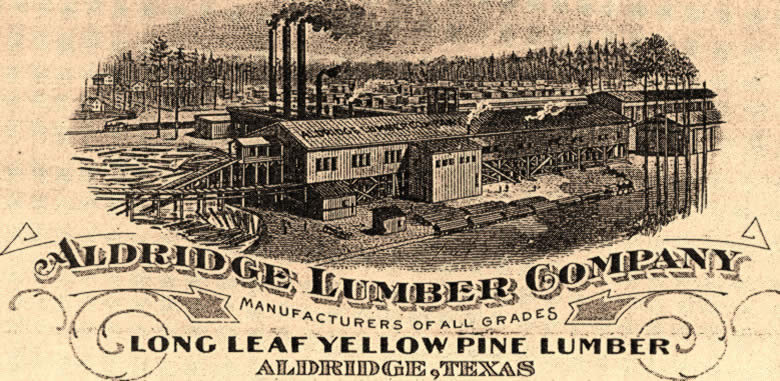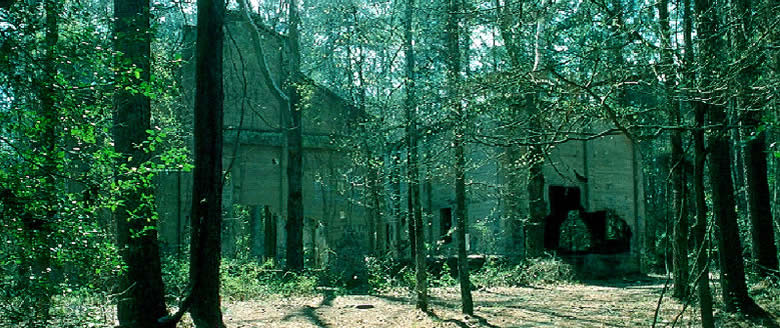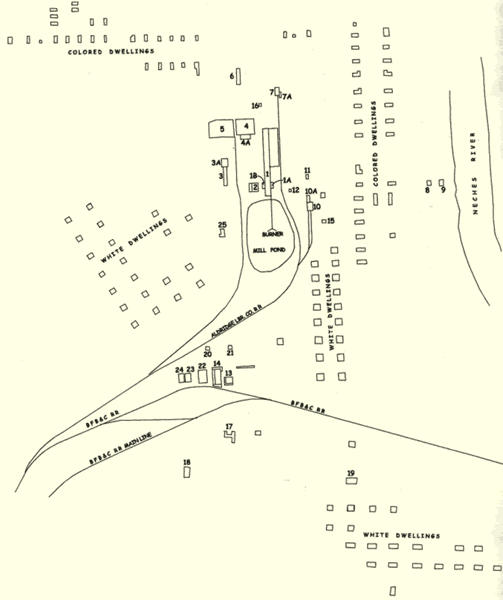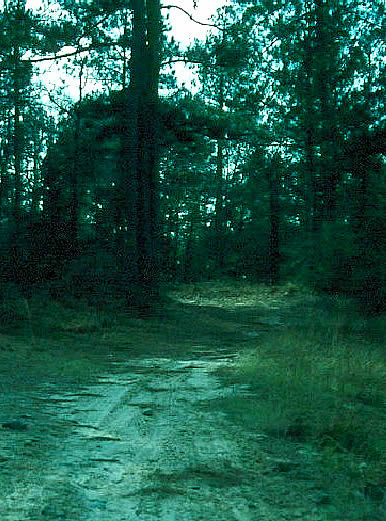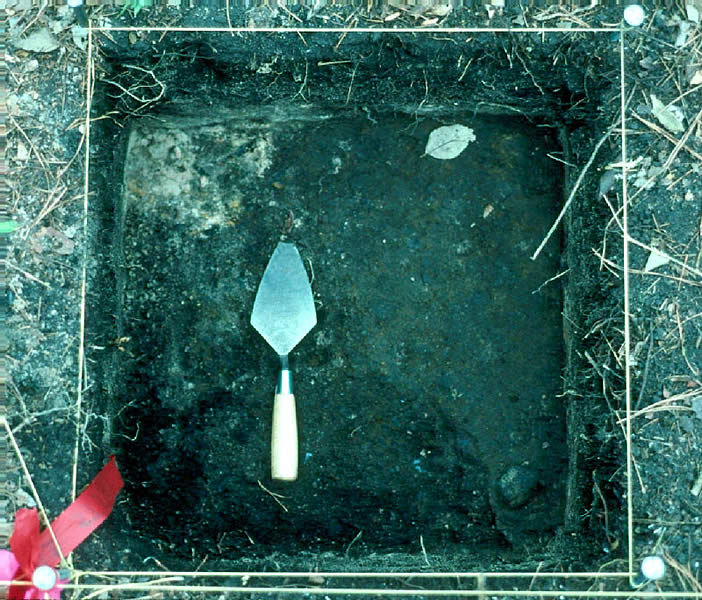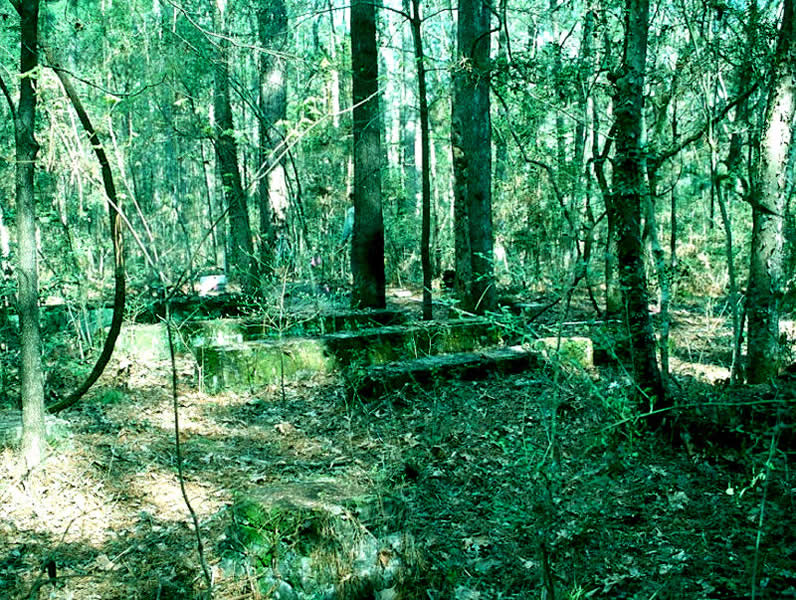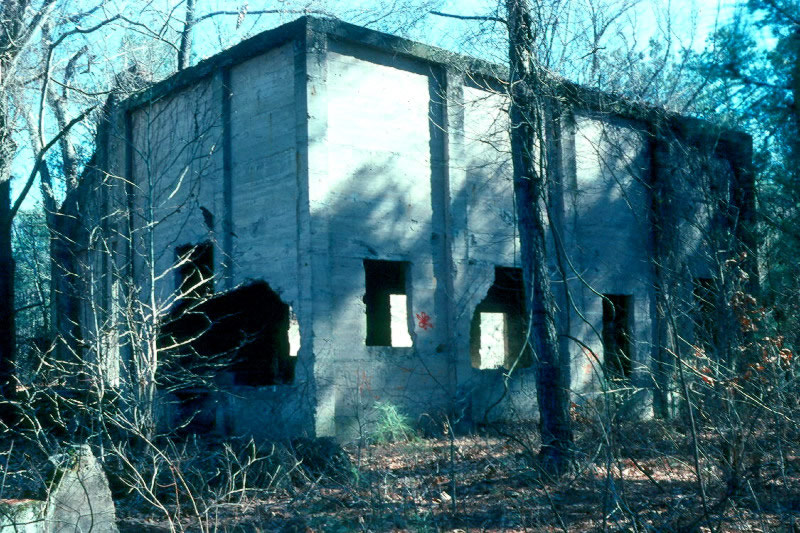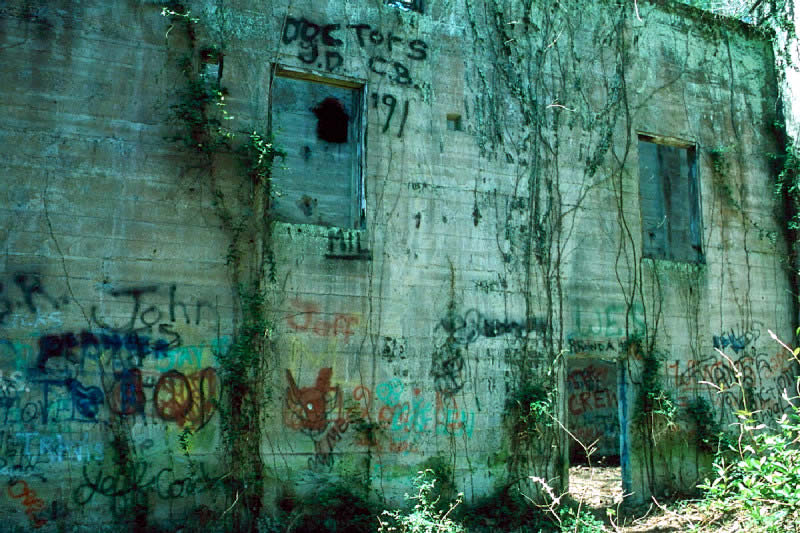
USDA forest workers
continue to search for chemical compounds
that will remove graffiti painted on
the porous concrete walls of the mill
ruins.
|
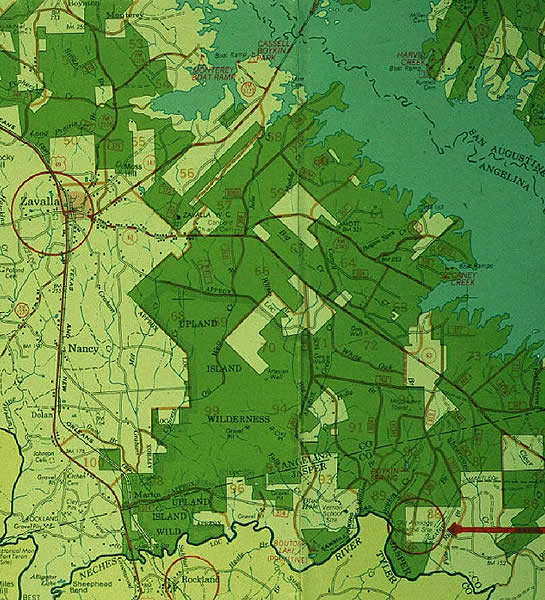
The Aldridge Sawmill and Township
site (circled in red, lower right) is located in the
longleaf pine woods of the Angelina National Forest
in East Texas. It sits on a high terrace adjacent to
a scenic bend of the Neches River in the extreme northeastern
portion of Jasper County. Click to see full image.
|

A driver maneuvers
a flatboat ferry across the river at
Aldridge.
|
|
Recollections of Mittie Mae Blake Dykes,
age: 102 1/2
Mittie was born in 1894, in Angelina County, Texas.
She had 5 brothers and sisters, most of whom died early
on of pneumonia. She recalled that Aldridge had "nice
houses and a nice big school," with many children
going to it. Everyone around worked in the mill, whites
and blacks together. "There was a big kitchen at
Aldridge where you could buy dinner" (the noon
meal). They also had a doctor's office, drug store,
barber shop, and a kitchen—"a big, long house
with big, long tables and benches on each side."
The main cook was a man, and about 10 women worked with
him there from daylight until dark. According to Mittie,
she didn't ask to work in the kitchen; they "just
came and got her." Someone had told them she could
cook.
Mittie's husband Jess was a carpenter who worked outside
the mill. He made furniture and also worked at the blacksmith
shop. Jess played the fiddle for the dances at Aldridge
and other places, and Mittie liked to dance. They were
married in May, 1918. Jess died in 1940 at age 50, from
pneumonia.
--(Interview by Faye Green, October 16, 1996.)
|

Company houses provided
for both white and African -American
workers were described as "comfortable,"and
likely resembled those in this photo
of the "colored quarter" in an unknown
milltown. Photo courtesy Stephen F.
Austin State University Forest History
Collections, Thompson Photo Collection.
|

A tranquil scene
of the Aldridge millpond. Click to see
full image.
|

A fishing scene at
a muddy river in East Texas, near the
turn-of-the-20th century. Photo courtesy
of Texas Tides digital collection (TXK
p86n2).
|
|
There is no sign of residential structures, school,
churches, commissary or hotels—only second—growth
timber now stands where a community once thrived.
|
|
Forest workers, historians, and East Texas residents
have long been aware of the slow cycle of destruction occurring
at the Aldridge Sawmill site. Hidden deep in the Angelina
forest, the high-walled ruins are a magnet for "artists"
wielding spray-paint cans and artifact hunters seeking items
left behind by millworkers and townspeople nearly a century
ago. Nature has taken its toll as well; vines crawl over the
porous concrete walls, and shrubs and trees have invaded the
building interiors.
Measures to stabilize, investigate, and protect
the Aldridge site—one of the few remaining sawmill ruins
left in East Texas forests—have been in the works for
over a decade, although lack of funding and manpower continues
to slow progress. Volunteer efforts have helped turn the tide.
During a two-week period in 1995 and 1996, the USDA Forest
Service, National Forests and Grasslands of Texas, hosted
a Passport In Time (PIT) project focusing on the Aldridge
Sawmill and Township. Volunteers from across the United States
came to help with the investigations at the site. During that
time, visitors coming to view the ruins told of their family
members who had lived or worked at Aldridge.
The following "snapshot"
of the Aldridge Sawmill and community—as
it appeared in the past and as it appears
to visitors today—is based on information
collected from these efforts as well as historical
research and oral history interviews conducted
by the USDA Forest Service staff.
Boom and Bust
Hal Aldridge was a young entrepreneur
from Rockland, Texas, where he first gained
experience as a sawmill owner and operator.
He bought the Rockland sawmill in 1890, and
as this mill prospered, he began to purchase
lands with "high quality" timber
(undoubtedly longleaf pine) in Angelina and
Jasper counties. With a vision of building
a mill closer to his new timberland holdings,
Aldridge sold the Rockland Sawmill in 1898.
He chose the site for his new mill carefully,
locating it on the east bank of the Neches
River at a bend downstream from what was once
known as Boon's Ferry crossing.
At that time, the river-bend site already had
a logging history. Since the 1840s, it apparently had been
a gathering and shipment point for rafting logs down the Neches
River to the coastal city of Beaumont. The river would continue
to be an important factor in the new sawmill—the water
was used for boilers, train engines, and for fighting fires.
The river channel provided transportation and storage space:
logs were floated downstream, and log booms could be set up
to store logs for future production. There were two other
important resources to be exploited in this area; the lumber
produced from the pines and the rocks from the nearby quarries.
After the great hurricane nearly destroyed Galveston in the
early 1900's, rock from the quarry near Aldridge was used
to build the long barrier jetty.
Another critical factor was veteran lumberman
John H. Kirby's plan to build an east-west railroad to the
site of Aldridge Mill. As a landowner in the area, Kirby had
an eye on future business development. By building the Burrs
Ferry, Browndell and Chester Railroad (BFB&C), he could
ensure that products would reach their markets.
Hal Aldridge, however, did not
wait for the railroad to be built. He began
building the wooden sawmill in 1903, completing
construction by 1905. A Herculean effort then
ensued to outfit the remote site: hundreds
of men and tons of machinery were brought
in. Four massive boilers were hauled by oxcarts
with huge wooden wheels through the forests
to the Aldridge Mill. Concurrently, work proceeded
on building the railroad. By 1906, the BFB&C
Railroad extended to the rock quarries just
northwest of Aldridge and, a year later, finally
reached the sawmill. This 11-mile tram line
ran from Rockland, to Aldridge, to the Neches
river.
The sawmill enterprise at Aldridge got underway
successfully, with production reaching 75,000 board feet of
lumber daily. But the wooden mill buildings were crowded,
unsafe, and proved to be a fire hazard. On August 25, 1911,
the mill burned to the ground.
At this time, the Aldridge mill was the only
sawmill operating in the vast timber region. Other mills had
already closed, and the decision to rebuild seemed a wise
business strategy. To ensure greater safety and avoid increased
insurance rates, the layout of the mill was changed to provide
adequate spacing between the buildings. By 1912, the mill
had been rebuilt, with buildings to house the engine, boiler,
fuel room, and dry kiln constructed primarily of concrete
reinforced with iron beams and furnished with state-of-the-art
machinery, including a single-cutting band saw and a resaw.
With the new improvements, the Aldridge Lumber
Company once again saw success. In a short time, the mill
was producing 125,000 feet of lumber a day. Hal Aldridge employed
500 workers, some harvesting timber in the woods, others working
at the mill—the largest roster of any lumber company
at the time. And as the mill rose from the ashes, so did the
town. By 1913, some 1000-1500 folks lived in 200 company houses
in the quiet, neatly arranged community of Aldridge.
Segregation in towns and cities was common,
and Aldridge and other sawmill communities were no exception
even though black and white workers often worked side-by-side
in the woods. Accommodations in both the "colored"
area (the area reserved for African Americans) and "white"
area were described as simple frame houses with wide front
porches. (Mill owner Hal Aldridge, however, built what is
described as a rather "palatial mansion" for himself.)
Although some descendants of former residents recall that
homes rented to white workers were somewhat nicer than those
for blacks, no one interviewed recalled racial tension or
labor disputes in the small community.
A central focus of the town was the company
commissary, where workers could purchase food and furnishings
with discount tokens provided by the mill. There was also
20-room hotel for travelers, a post office, blacksmith shop,
train depot, two schools, shops, saloons, and other typical
enterprises found in small towns. A large community vegetable
garden provided free produce for the workers.
But success and prosperity at Aldridge again
were to be fleeting. On October 22, 1914, the mill was struck
by an arsonist. Twice hit by misfortune, Hal Aldridge elected
to quit the lumber business and move to EI Paso, leaving his
operation in care of company Vice President F. W. Aldridge
(assumed to be Hal Aldridge's brother.) Fortunately, the October
22 fire had been discovered shortly after it started, and
only minimal damage was done. Nonetheless, business at the
mill began trending downward, most likely due to the depletion
of the pine forest in the area. And in 1919, yet another fire
delivered the final death blow to Aldridge.
By 1920, the town of Aldridge was nearly abandoned. Kirby
Lumber Company eventually bought the mill, and a few loyal
and faithful Kirby employees kept the mill operating. During
the next decade, they built houses using wood from the mill
houses, fenced the living areas, and farmed the land, according
to 1990s interviews with residents. But in 1927, the railroad
spur from nearby Rockland to Turpentine was closed, further
blighting efforts to rekindle enterprise at Aldridge. The
U. S. Forest Service eventually took possession of the property,
and it was annexed into the Angelina National Forest.
In 1941, the Forest Service replanted the area
immediately next to the sawmill. In subsequent years, staff
have taken measures to document the historic site, replant
trees, and manage and abate insect infestations (the general
practice was to cut and leave on the ground those pine trees
infested with the southern pine beetle). The pine forest to
the north of the sawmill, where the "white" residences
were, was cut a second time, and the land is currently producing
a third (historically) generation of pine. The last planting
took place in 1984, and the resulting pine plantation is nearly
impenetrable.
Ruins in the Woods
|
|
In this section:
|

Working with a USDA
Forest Service staff person, volunteers
from the Passport in Time project dig
shovel tests in the Neches River terrace
adjacent to the Aldridge sawmill ruins.
The soil is sifted through screens for
small artifacts.
|

School at Aldridge,
date unknown
|
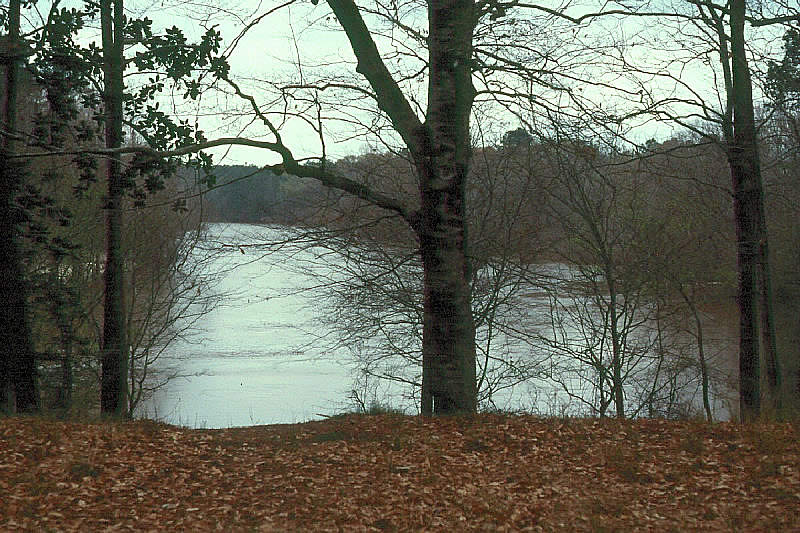
The Neches River near the Aldridge
site. The river was a critical factor in siting the
sawmill, providing water for the mill boiler engines
and a route for boat transportation in its deep channel.
|
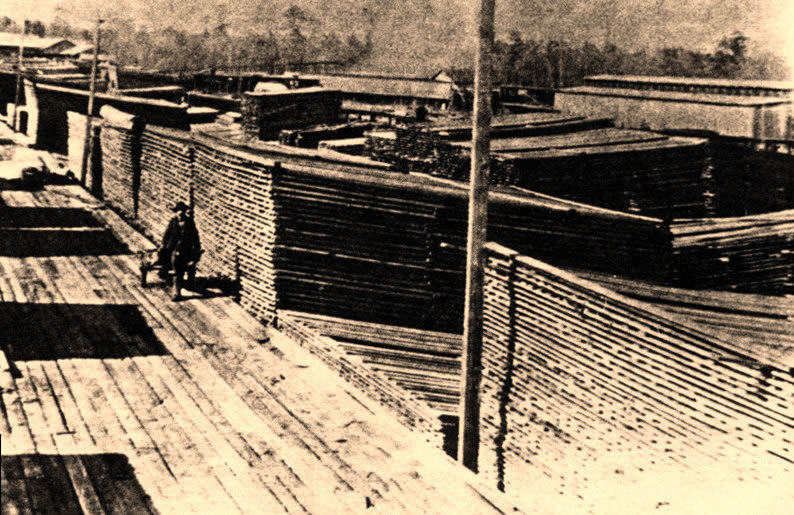
Flanked by piles
of pine lumber stacked high on each
side, a worker walks through the Aldridge
lumberyard.
|

"Mill Goes Up in
Smoke." News account of the first Aldridge
sawmill fire, of unknown cause, as reported
in the Beaumont Journal, Aug. 26, 1911.
Click to enlarge.
|
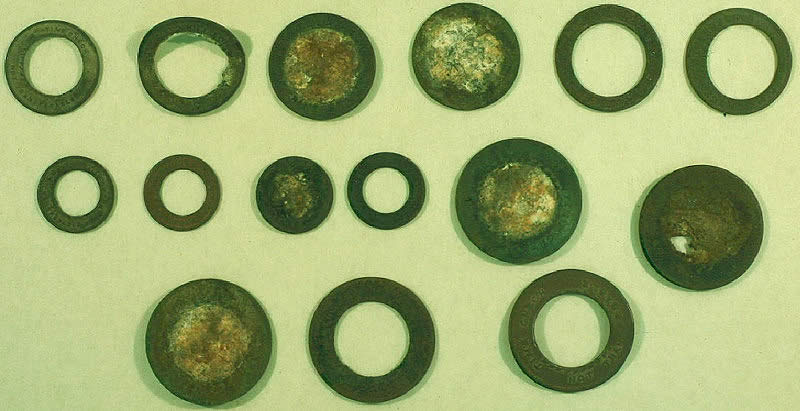
Tokens excavated
by PIT volunteers during Aldridge site
investigations. The "punch outs were
paid to Aldridge Lumber Company employees
and could be redeemed for a 10 to 20
per cent discount on merchandise in
the huge Aldridge commissary. Photo
courtesy USDA Forest Service.
|
|
Recollections of R.Z. Hinson, age 79
R.Z was born in 1917 in Aldridge Sawmill Town. He
recalls that he and his family lived in a frame board
and batten house with four rooms, a wood heater, and
a front porch. The houses were fairly close together,
and there was a well between every second house and
the next. They had "colored" quarters and
white quarters. For Fourth of July at Aldridge, they
would spend the week before fishing in the river, and
kept the fish alive in a box in the water. Then they
would have a big fish fry behind grandpa's house on
the river. His grandpa once caught a 49-pound cat fish
with clabber milk for bait, tied up in a rag in a net.
-- Interview by Fay Green, May 22, 1997.
|
|
